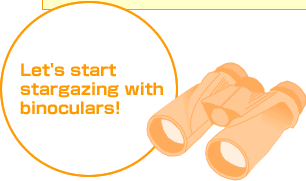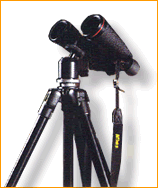 |
 |

For
all of recorded history and much beyond, humans have
been fascinated with the stars, as evidenced by the
cave drawings of early man through to the mystic symbols
and horoscopes drawn up by the ancients.
Winter is the perfect season for stargazing because the air
is transparent and the sky is clear. The winter skies host
a multitude of first- and second-magnitude stars that are
easy to locate, even with the naked eye. But once you graduate
from the naked eye to binoculars, you will realize that you
have entered a different level of perception. Try it! |
|
 |
|
 |
 |
 |
 |
 |
| • |
A dry night
with low humidity is perfect for observing stars because the
air is clearer. |
| • |
The moon is actually
brighter than you think - it can be a distraction - so you
will be able to see more stars when the moon is not prominent. |
 |
|
|
|
 |
| • |
Anywhere
you have a clear view of the four cardinal compass points is
a good place for stargazing because you can look at stars in
any direction. |
| • |
Street lighting and
bright illuminations will prevent a clear view of the stars,
so look for a place that has a bare minimum of artificial lighting. |
| • |
Be aware of your surroundings.
Do not stargaze while standing out on the street or unstable
ground such as waterfronts or cliffs. |
|
|
|
 |
 |
 |
 |
 |
| • |
You can
enjoy stargazing from your window or balcony. |
| • |
If there are streetlights
nearby, use your hand to shield out the light so that it is
easier to see the stars. |
| • |
At midnight, when the
lights go out in residential areas, you will be able to see
more stars. |
|
|
|
 |
 |
|
 |
 |
 |
 |
| • |
Wait in
the dark for 10 to 30 minutes until your eyes become accustomed
to the darkness. |
 If
you are going to join a group of people already watching
stars, wait until your eyes are fully accustomed to the
darkness before approaching
them. Don't wander up to them waving a flashlight everywhere
as this will spoil their night vision. Be careful not to
interfere with other
people who are observing the stars. If
you are going to join a group of people already watching
stars, wait until your eyes are fully accustomed to the
darkness before approaching
them. Don't wander up to them waving a flashlight everywhere
as this will spoil their night vision. Be careful not to
interfere with other
people who are observing the stars. |
| • |
Use a posture
that allows you to comfortably look up the skies. |
 Lie
on a sleeping bag or sit on a chair. If you lie on the
ground in winter, place a thermal insulation sheet or cardboard
under the sleeping bag to protect yourself against the
cold ground temperature. If you use a chair, choose a recliner. Lie
on a sleeping bag or sit on a chair. If you lie on the
ground in winter, place a thermal insulation sheet or cardboard
under the sleeping bag to protect yourself against the
cold ground temperature. If you use a chair, choose a recliner. |
|
 |
 |
| • |
Take
a good look around the starlit sky without the binoculars
to get your bearings. |
 If
you arrive before dusk, note where the sun sets. That direction
is west. Even if you do not have a compass you can estimate
where the star you want to see will appear. If
you arrive before dusk, note where the sun sets. That direction
is west. Even if you do not have a compass you can estimate
where the star you want to see will appear. |
| • |
Choose a bright
star as a reference point. Consult a star atlas or star
chart to establish the location of galactic clouds or star
clusters. |
 It
is a good idea to visit a planetarium before you start stargazing
so that you can grasp the general locations of the stars
you want to watch. It
is a good idea to visit a planetarium before you start stargazing
so that you can grasp the general locations of the stars
you want to watch. |
| • |
After you have
located several stars with your naked eye, you can use
binoculars to get a clearer look at them. |
 The
moon can be easily observed with your naked eye but it looks
slightly different when you see it through binoculars. There
are many stars you can find with binoculars that are difficult
to see with your naked eye. The
moon can be easily observed with your naked eye but it looks
slightly different when you see it through binoculars. There
are many stars you can find with binoculars that are difficult
to see with your naked eye. |
| |
|
 |
 |
|
| |
 |
 |
Binoculars allow you to find far more stars
than with your naked eye.
Galactic clouds and star clusters look dim when you look at them
with your naked eye. But with binoculars you can see them quite clearly.
Unlike the inverted view seen through a telescope, binoculars show
you the world right-side up, just as you see things with your naked
eye. The other advantage over telescopes is that binoculars let you
see the world with both eyes.
Binoculars with a wide field of view, however, will allow you to
observe a wide area, making it easier to observe galactic clouds,
star clusters or comets. Apart from cases in which you want to thoroughly
observe a particular star, using binoculars for star watching generally
makes good sense as they give you a much better view of the stars
and make stargazing much easier. Binoculars are easy to operate so
you can concentrate fully on looking up into the sky. |
|
| |
| • Best
binoculars for stargazing |
| • |
Choose
binoculars that have an objective lens with a large effective
diameter or a large pupil diameter. |
 |
An aperture of 40 to
50 mm is suitable. When using an objective lens with an
aperture over 50mm, use a tripod to avoid image vibration
caused by binocular shake.
A pupil diameter of 5mm or larger is ideal. A diameter of
less than 3mm is not recommended for stargazing. |
|
| • |
Binoculars with
a high magnification tend to amplify the shakiness of your
hands. |
 |
Observe stars using
a posture that allows you to firmly grip the binoculars.
A magnification of 7x to 10x is suitable. It's a good idea
to mount the binoculars on a tripod to stabilize the field
of view and for safer observation over long hours. |
|
| • |
Binoculars with
high optical performance |
 |
High resolving power is necessary because you are going to observe stars, which are a point light source. Choose binoculars with high lens quality and performance that provide a sharp image to the periphery of the field of view. |
|
| • |
Waterproof or
water-resistant binoculars |
 |
Choose waterproof or
water-resistant binoculars so you don't need to worry about
using them in night dew or when there is sudden rainfall. |
|
| • |
Choose binoculars
that suit your observation style |
 |
Pick up the binoculars
and look through them. Find the model best suited to your
needs. |
|
| (When
fixing a binocular on a tripod, a tripod adapter is necessary.) |
|
|
| |
 |
|
 |
|
| |
|
|
Color of photographs
appearing in this www site may differ from the originals.
Specifications and equipment are subject to change
without any notice or obligation on the part of the manufacturer. |
| Terms of Use |
Privacy |
© 2009
Nikon Vision Co., Ltd. |
|

